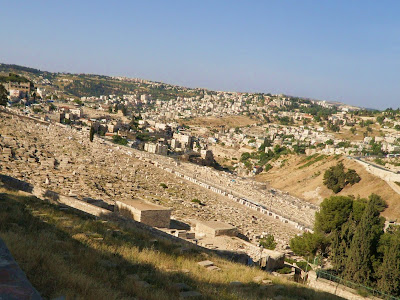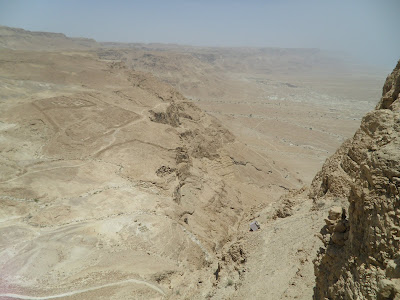
The view of the Temple Mount from the Mount of Olives. We were up at 4:30 this morning so that we could have at least an hour to ourselves for Kay's teaching - it was worth it!
 In the foreground you see the Mount of Olives white with the stones of the Jewish Cemetery. You don't see flowers at a Jewish cemetery because visitors to the grave site leave stones instead. Though it is a strong Jewish tradition there does not seem to be agreement as to why this is done.
In the foreground you see the Mount of Olives white with the stones of the Jewish Cemetery. You don't see flowers at a Jewish cemetery because visitors to the grave site leave stones instead. Though it is a strong Jewish tradition there does not seem to be agreement as to why this is done.One of the things I read was that when the tradition started, grave monuments were mounds of stones. Visitors added stones to "the mound" to show you are never finished building the monument to the deceased. I'm sure there are several valid reasons why this tradition began.
 We are walking to the garden chapel of Dominus Flevit where Kay will teach with the Temple Mount as her backdrop.
We are walking to the garden chapel of Dominus Flevit where Kay will teach with the Temple Mount as her backdrop. Olive trees on the Mount of Olives with the sun hitting across the Kidron Valley on to the Dome of the Rock.
Olive trees on the Mount of Olives with the sun hitting across the Kidron Valley on to the Dome of the Rock. Looking across the Kidron Valley to the Temple Mount and the Eastern Gate. (Pat and I got up really early!!!)
Looking across the Kidron Valley to the Temple Mount and the Eastern Gate. (Pat and I got up really early!!!)
 According to Jewish tradition, the Messiah will appear here and bring the dead back to life. Therefore, the hillside became the most holiest cemetery, and the hillside is covered by thousands of grave stones.
According to Jewish tradition, the Messiah will appear here and bring the dead back to life. Therefore, the hillside became the most holiest cemetery, and the hillside is covered by thousands of grave stones.  Just above the trees you can see the gold onion shaped domes of the Russian Orthodox Monastery of St Mary Magdalene.
Just above the trees you can see the gold onion shaped domes of the Russian Orthodox Monastery of St Mary Magdalene. The view from the Mount of Olives is so beautiful and so full of meaning that it was hard to stop taking pictures.
The view from the Mount of Olives is so beautiful and so full of meaning that it was hard to stop taking pictures."But David continued up the Mount of Olives, weeping as he went; his head was covered and he was barefoot. All the people with him covered their heads too and were weeping as they went up." 2 Samuel 15:30
"Behold, the day of the LORD cometh, and thy spoil shall be divided in the midst of thee. For I will gather all nations against Jerusalem to battle; and the city shall be taken...Then shall the LORD go forth, and fight against those nations, as when he fought in the day of battle. And his feet shall stand in that day upon the Mount of Olives..." Zechariah 14:1-11
"But Jesus went to the Mount of Olives. Early in the morning He came again into the temple, and all the people were coming to Him; and He sat down and began to teach them." John 8:1-2

 Dominus Flevit ("the Lord has wept") is a Catholic Franciscan church. According to tradition, this is the site where Jesus was looking at the city, visualizing its destruction, and weeping over its fate. The location of the church fits the description in Luke 19 - on a descent from Mount of Olives and facing the temple mount.
Dominus Flevit ("the Lord has wept") is a Catholic Franciscan church. According to tradition, this is the site where Jesus was looking at the city, visualizing its destruction, and weeping over its fate. The location of the church fits the description in Luke 19 - on a descent from Mount of Olives and facing the temple mount.

 We are walking down "Palm Sunday Road". Starting at the top of the Mount of Olives, walking down Palm Sunday Road, and ending at the Eastern Gate, is the path that Jesus took his last days.
We are walking down "Palm Sunday Road". Starting at the top of the Mount of Olives, walking down Palm Sunday Road, and ending at the Eastern Gate, is the path that Jesus took his last days. The Eastern Gate with the muslim cemetery in front of it.
The Eastern Gate with the muslim cemetery in front of it. Note: The following video was taken with an iphone as I was taking notes in my Bible. I maintained a view of the temple mount and the Eastern Gate because the speaker was positioned there and it is always more important for me to get Kay's words than her face and I wasn't sure what kind of reception my iphone could get at what distance. I am pleased with the result! :)
There were many unforgettable and life-changing moments on this trip but Kay's teaching here was one of those moments. She spoke on Christ's coming and referenced Revelation, Matthew 24 and closed with Zechariah 14. The above video is the climax of our time on the Mount of Olives.
Zechariah 14 speaks of the day when the LORD will return to fight Jerusalem's foes.
"In that day His feet will stand on the Mount of Olives, which is in front of Jerusalem on the east; and the Mount of Olives will be split in its middle from east to west by a very large valley, so that half of the mountain will move toward the north and the other half toward the south. You will flee by the valley of My mountains, for the valley of the mountains will reach to Azel; yes, you will flee just as you fled before the earthquake in the days of Uzziah king of Judah. Then the LORD, my God, will come, and all the holy ones with Him!" Zechariah 14:4-5
"And the LORD will be king over all the earth; in that day the LORD will be the only one, and His name the only one." Zechariah 14:9
Kay closed with this question... "Does He have the preeminence in your life as the only One, the King of Kings? Precious ones, He is coming again and His reward is with Him. And the question is are you ready?" Our time ended with the song Midnight Cry.
Midnight Cry
VERSE 1
I hear the sound
Of a mighty rushing wind
And it's closer now
Than it's ever been
I can almost hear the trumpet
And Gabriel sounds the chord
At the Midnight Cry
We'll be going home
CHORUS
When Jesus steps out
On a cloud to call his children
The dead in Christ shall rise
To meet him in the air
And then those that remain
Will be quickly changed
At the Midnight Cry
When Jesus comes again
VERSE 2
I look around me
I see prophecies fulfilled
And signs of the times
They're appearing everywhere
I can almost hear the father
As he says
Son go get your children
At the Midnight Cry
The bride of Christ will rise
REPEAT CHORUS + TAG
TAG:
And then those that remain
Will be quickly changed
At the midnight cry
When Jesus comes again
At the midnight cry
When Jesus comes again
When Jesus comes again





























 Kenny pointed out that it was here that the Jews decided on their fate.
Kenny pointed out that it was here that the Jews decided on their fate. This is the Northern Palace or otherwise known as King Herod's residential palace. We did not climb down to see this but I will on my next visit!!
This is the Northern Palace or otherwise known as King Herod's residential palace. We did not climb down to see this but I will on my next visit!!




